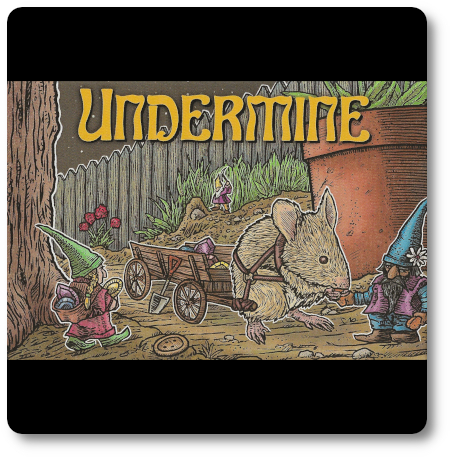 The Basics:
The Basics:
- For ages 6 and up (publisher suggests 12+)
- For 1 to 5 players
- Approximately 30 minutes to complete
Geek Skills:
- Counting & Math
- Logical & Critical Decision Making
- Pattern/Color Matching
- Strategy & Tactics
- Hand/Resource Management
Learning Curve:
- Child – Easy
- Adult – Easy
Theme & Narrative:
- Dig deep and dig fast to collect – and then sell – as many resources as possible!
Endorsements:
- Gamer Geek rejected!
- Parent Geek approved!
- Child Geek approved!
Overview
Garden Gnomes have long since been a staple for those who enjoy making their garden a whimsical place. During the day, they bring joy to those who find them under bushes and trees. At night, however, these same gnomes come alive and go underground to find precious gems and rare mushrooms. They dig deep and fast as they only have the time afforded them at night to toil for riches. In this game, you must help your gnomes find the best path to collect as much wealth as possible. It’s dirty work, but some gnome has to do it.
Undermine, designed by JT Smith and published through the Game Crafter, is comprised of five Garden cards, 12 Storage cards, 13 Wagon cards, five “100 Money” cards, 30 Tunnel cards, 144 Resource cards, ten cubes, and one Reference card. The card’s quality is equivalent to your standard playing card, but none of the cards come in the standard size. This is only a concern for those who like to sleeve your cards. Illustrations by Jason Glover continue to delight and provide a colorful thematic element to the game.
Getting Ready to Mine
To set up the game, complete the following steps.
First, take the Resource cards, shuffle them, and then spread them around in the middle of the playing area. Cards may overlap but should ensure that each card’s resource is visible. Cards can also be apart, but keep the gaps between them as small as possible. When completed, you’ll have what is referred to in the game as the “Mine.”
Second, give each player one Garden card, one Wagon card, five Tunnel cards, and two cubes. Each player should place the Garden card in front of them at this time, ensuring the white dot found towards the Garden card’s corner is facing the Mine, and the Garden card is touching at least one card in the Mine. The Garden card provides players a starting point for their tunnels, initial storage, a means to keep track of Money, and handy reminders.
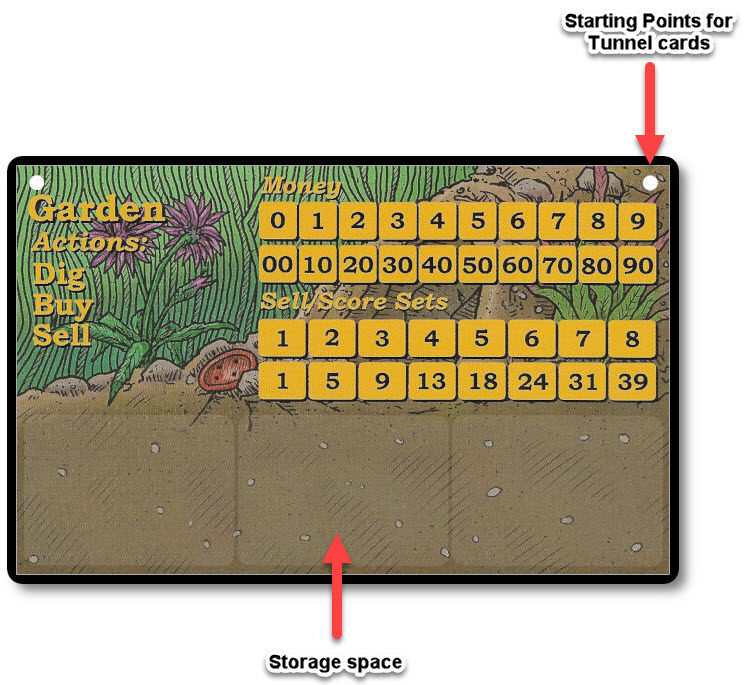
Third, each player should place one of their cubes on the Garden card’s Money track “5” space and the “00” space. This represents the player’s starting Money. Place any unused Garden cards and cubes back in the game box at this time.
Third, place five Tunnel cards off to one side of the Mine, placing the remaining Tunnel cards back in the game box. Place the remaining Wagon, Storage, and “100 Money” cards off to one side and within easy reach when needed in the game. This area is referred to as the “Market.”
That’s it for game setup. Determine who should go first and begin.
Down Deep in the Garden
Undermind is played in turns with no set number of turns per game. A player’s turn consists of taking one of three possible actions. These actions are summarized here. Once the player takes their selected action, the next player, in turn order sequences, takes their chosen action. This continues until the endgame condition is met.
Dig or Collect One Resource
The Dig action allows the player to take one Tunnel card they currently have in their possession and connect it to an existing Tunnel card that originated from the player’s Garden card or to the Garden card itself. Tunnel cards connect at the points where there is a visible white dot. From this white dot, Tunnel cards can extend the tunnel or branch off in another direction. They can even go over previously placed Tunnel cards.

Once placed, the player takes every Resource card that touches the Tunnel card. Every Resource card collected must immediately be placed in the player’s storage. Every Garden card comes with storage but is limited to only three Resource cards. Players can purchase additional storage if they like.
There are two significant Resources in the game. These are gems (five different types), which can be sold for “Money” during the game, and mushrooms (three different types) that are used at the end of the game when calculating a player’s final score.
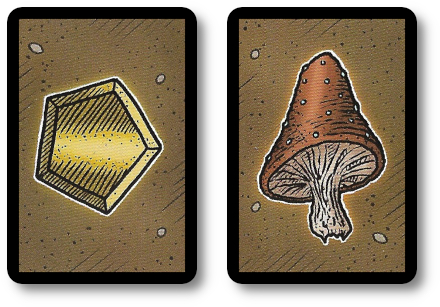
If a player does not have the storage space available to house the collected Resources cards, they must choose what they can store and discard the rest to the game box.
Optionally, if the player does not want to place a Tunnel card or is unable to, they may collect any single Resource card on the outside edges of the Mine. The same rules apply for storage, of course.
Buy
The Buy action allows the player to purchase one card in the Market.
- A Tunnel card costs one “Money.”
- A Wagon card costs four “Money.”
Calculating the cost of a Storage card is a bit more work. A Storage card costs the same amount in “Money” as the player’s current storage capacity. At the start of the game, each player has a storage capacity of “three” (per their Garden card). That means the first time the player purchases a Storage card, it will cost them three “Money.” Each Storage card will provide the player with an additional six storage spaces. The second Storage card the player will purchase will jump from three “Money” to nine “Money” as a result.
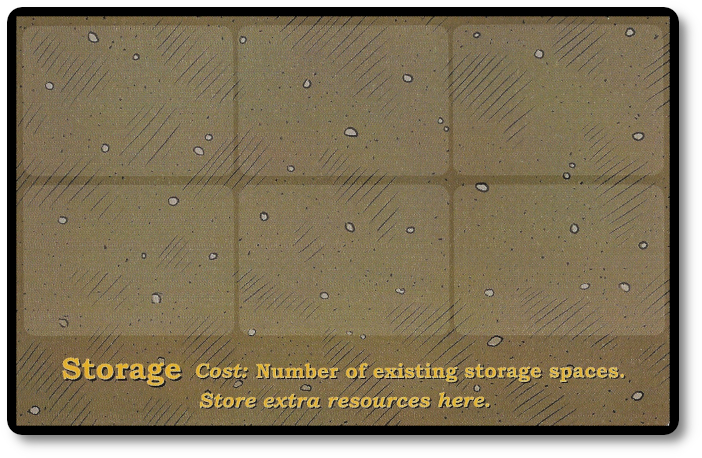
When purchasing from the Market, the player must be able to pay for the card. This is done by moving the cube on the Money track found on the player’s Garden card. Each player starts with five “Money.”
Sell
After collecting gem Resources, players may turn around and sell them for Money. Gem Resources are sold in sets of either the same type or all of a different type. The larger the sets, the more Money will be earned. Players cannot sell mushrooms during this action.
For example, selling a single Resource will net the player “one” Money, but selling three of the same or three different Resource cards will get the player nine “Money.” This is also noted on the player’s Garden card.
The total number of Resource cards that can be sold is determined by the number of Wagon cards the player currently has in their possession. At the start of the game, each player has access to one Wagon card, allowing the player to sell a maximum of two Resource cards. An additional Wagon card would enable the player to sell four Resources cards. There is no limit to the number of Wagon cards the player may have in their possession.
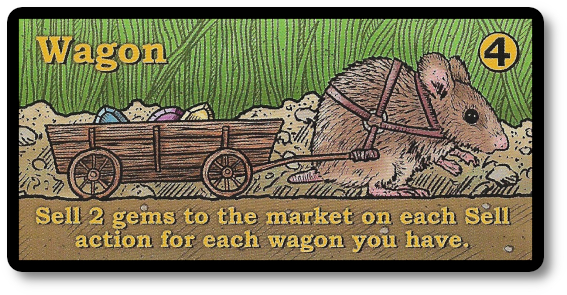
Any gem Resource cards sold are placed in the game box.
Leaving the Mine
The game comes to an end when either of the two following conditions is true.
- No player has a Tunnel card to play on their turn
- Any player has 50 or more “Money.”
The game is now over, and it’s time to determine each player’s final score.
First, each player may now sell any remaining sets of gem Resources they may have still in storage. Wagon restrictions do not apply at the end of the game, allowing players to sell as extensive a set as possible and as many times as possible, as long as they don’t reuse the Resource cards. Which is to say, once you use them, they are lost.
The mushroom Resource card may now be used. If players have the correct number and type of Resource cards, they could score up to 39 points with eight Resources in their set.
If a player has 100 or more “Money,” take a “100” Money card from the supply.
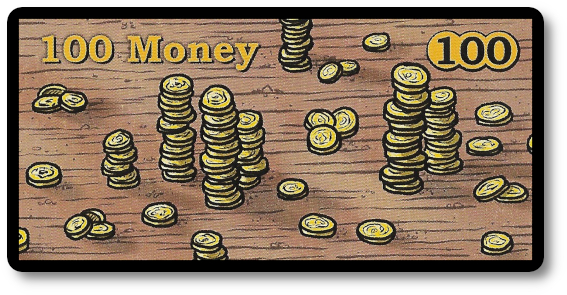
After all the players have completed their final selling of Resources and adjusted their Money track accordingly, the player with the most money wins the game. If there is a tie, the player with the next highest score (that is not tied) wins the game.
Game Variants
You can play Undermine alone if that is your thing. The rules or very similar with the addition that a Money card is dropped after each turn onto the Mine. Any Resource cards the Money card lands on are removed from play. The player is also provided rules to include an Automata, which introduces a self-operating imaginary second player.
When playing the game with two or three players, remove roughly half of the Resource cards when setting up the game. These removed cards are placed back in the game box until you play the game with more friends.
To learn more about Undermine, visit the game’s webpage.
Final Word
 The Child Geeks enjoyed the game, finding it great fun to build and extend their tunnel to collect cards. According to one Child Geek, “I liked the game a lot. It reminded me of that old game Pick-Up-Sticks, but it was much more fun than picking up sticks. I also don’t like mushrooms; I think they taste yucky, but I also like how much money they can get me.” Another Child Geek said, “The game was easy to learn and fun to play with my family. I thought the mouse horse was really cute, and I think all the gnomes work too hard.” Labor laws set aside, the Child Geeks all took a vote when the last gnome emerged from the Mine. The result was a clear and loud “approved” by our youngest and most inexperienced of players.
The Child Geeks enjoyed the game, finding it great fun to build and extend their tunnel to collect cards. According to one Child Geek, “I liked the game a lot. It reminded me of that old game Pick-Up-Sticks, but it was much more fun than picking up sticks. I also don’t like mushrooms; I think they taste yucky, but I also like how much money they can get me.” Another Child Geek said, “The game was easy to learn and fun to play with my family. I thought the mouse horse was really cute, and I think all the gnomes work too hard.” Labor laws set aside, the Child Geeks all took a vote when the last gnome emerged from the Mine. The result was a clear and loud “approved” by our youngest and most inexperienced of players.
 The Parent Geeks found Undermine to be casual and – if you’ll excuse the pun – deep enough in the gameplay to make each turn enjoyable to observe and complete. According to one Parent Geek, “At first I thought, what is this mess of a game? Look at all these cards spread out on my table. My OCD was itching to collect them all and put them in an orderly stack! What I found, however, was a game I enjoyed playing. It is strangely satisfying building a tunnel into that mess and making order of it on my Garden card.” Another Parent Geek said, “A fun and light game. I enjoyed it with my family and friends. Very easy to pick up and play. I had no idea garden gnomes were such hard workers.” When the last wagon was loaded, the Parent Geeks took stock and found Undermine worth a great value.
The Parent Geeks found Undermine to be casual and – if you’ll excuse the pun – deep enough in the gameplay to make each turn enjoyable to observe and complete. According to one Parent Geek, “At first I thought, what is this mess of a game? Look at all these cards spread out on my table. My OCD was itching to collect them all and put them in an orderly stack! What I found, however, was a game I enjoyed playing. It is strangely satisfying building a tunnel into that mess and making order of it on my Garden card.” Another Parent Geek said, “A fun and light game. I enjoyed it with my family and friends. Very easy to pick up and play. I had no idea garden gnomes were such hard workers.” When the last wagon was loaded, the Parent Geeks took stock and found Undermine worth a great value.
 The Gamer Geeks enjoyed the game, but not nearly as much as our Child and Parent Geeks. As one Gamer Geek put it, “A simple game of collecting cards but with a neat twist that the players get to dig through the resources through paths. I enjoyed the concept and the gameplay, but the game was too light for me to approve. I think it is excellent for new and casual players. Just not a game I would want to put on my table with my other friends who like more complicated games.” Another Gamer Geek said, “Good game. Tight rules. Interesting gameplay. All the making of a great game, and I think it is a winner, but not a game with enough going on to make me want to play it again. My kids will love it, and my wife will, too. Anything to stop playing Uno or Monopoly. Undermine will be a welcomed addition to my family table but won’t find time on my gaming table.” When the last resource was collected, the Gamer Geeks all agreed that Undermine was less than what they were looking for.
The Gamer Geeks enjoyed the game, but not nearly as much as our Child and Parent Geeks. As one Gamer Geek put it, “A simple game of collecting cards but with a neat twist that the players get to dig through the resources through paths. I enjoyed the concept and the gameplay, but the game was too light for me to approve. I think it is excellent for new and casual players. Just not a game I would want to put on my table with my other friends who like more complicated games.” Another Gamer Geek said, “Good game. Tight rules. Interesting gameplay. All the making of a great game, and I think it is a winner, but not a game with enough going on to make me want to play it again. My kids will love it, and my wife will, too. Anything to stop playing Uno or Monopoly. Undermine will be a welcomed addition to my family table but won’t find time on my gaming table.” When the last resource was collected, the Gamer Geeks all agreed that Undermine was less than what they were looking for.
 Undermine is a great game to get to your family table. It’s indeed easy to set up and start playing. Due to how the Mine is created, players will be challenged to navigate a different underground every time. To the Gamer Geeks’ point, however, players will always take the same approach and never attempt to do anything other than collect what they can to be sold off as quickly as possible. There are no shifting market values, only limitations of availability based on how a player chooses to navigate the Mine. Depending on the number of players, it will be really easy or downright frustrating as players scrounge through limited resources via an ever-expanding tunnel system.
Undermine is a great game to get to your family table. It’s indeed easy to set up and start playing. Due to how the Mine is created, players will be challenged to navigate a different underground every time. To the Gamer Geeks’ point, however, players will always take the same approach and never attempt to do anything other than collect what they can to be sold off as quickly as possible. There are no shifting market values, only limitations of availability based on how a player chooses to navigate the Mine. Depending on the number of players, it will be really easy or downright frustrating as players scrounge through limited resources via an ever-expanding tunnel system.
One aspect of the game that should be noted is the constant need to juggle resource collection and purchasing goods to house and sell the resources. Players start with enough to make a good go of it but need to invest in extra storage and a wagon or two to be competitive. The additional storage space, tunnels, and fleet of wagons needed depend entirely on time available to the player. As a result, a game with fewer players will result in players investing more in the gnomish infrastructure, while more players will shift the player’s focus on collecting and selling as rapidly as possible.
Each turn in this game is meaningful and impactful. So much so that a single player’s turn could make the difference at the end of the game, resulting in victory or a close one. This was found to be a bit frustrating to our more casual players from time to time as they felt a bit hamstrung due to limited turns and actions. Each choice, you see, is essential. The downside is that a player can only make one per turn. I think limitations foster creative thinking and logical decision-making. For others, however, it felt a bit oppressive at times.
The game’s casual approach to collecting and selling resources made even our most disgruntled gnome player smile. It didn’t win the Gamer Geeks’ hearts, but it made them think. For our casual and inexperienced players, Undermine provided genuine enjoyment. So do dig into this game when the opportunity is at your gaming table.
This game was given to Father Geek as a review copy. Father Geek was not paid, bribed, wined, dined, or threatened in vain hopes of influencing this review. Such is the statuesque and legendary integrity of Father Geek.



